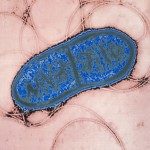Link to Pubmed [PMID] – 38750030
Link to DOI – 10.1038/s41467-024-48219-y
Nat Commun 2024 May; 15(1): 4093
Plasmids carrying antibiotic resistance genes (ARG) are the main mechanism of resistance dissemination in Enterobacterales. However, the fitness-resistance trade-off may result in their elimination. Chromosomal integration of ARGs preserves resistance advantage while relieving the selective pressure for keeping costly plasmids. In some bacterial lineages, such as carbapenemase producing sequence type ST38 Escherichia coli, most ARGs are chromosomally integrated. Here we reproduce by experimental evolution the mobilisation of the carbapenemase blaOXA-48 gene from the pOXA-48 plasmid into the chromosome. We demonstrate that this integration depends on a plasmid-induced fitness cost, a mobile genetic structure embedding the ARG and a novel antiplasmid system ApsAB actively involved in pOXA-48 destabilization. We show that ApsAB targets high and low-copy number plasmids. ApsAB combines a nuclease/helicase protein and a novel type of Argonaute-like protein. It belongs to a family of defense systems broadly distributed among bacteria, which might have a strong ecological impact on plasmid diffusion.






